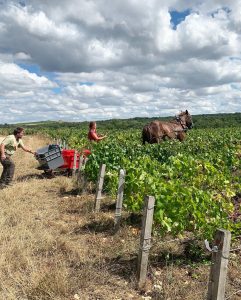‘’Organism Agriculture’’ in vineyards refers to complete autonomy, that is, a winery’s independence to supply all of its needs within itself.
Ruppert-Leroy practices polyculture and farms not just vines (which would be a monoculture), but also raises cows, sheep, chickens, rabbits, and horses. As the winery does not use any type of added SO2 during the vinification process, the only outside purchases currently being made are small doses of copper, sulfur against odium, and organic grape must for secondary fermentation. Even then, the copper usage is extremely limited, and the majority of it is replaced by biodynamic preparation sprays – infusion of nettles, reine des près (meadowsweet), and chamomile.


In the region champenoise, It is unique that Ruppert-Leroy has the space to practice this ‘vertical’ idea of biodynamics. Even the vegetable feeds for the cows are grown near the vine sites, so that the cow manure will share the same microorganisms as the vine soils. Similarly-minded neighbouring winemakers such as Vouette & Sorbée, Fleury, Val Frisson, and Horiot make regular exchanges with Ruppert-Leroy. Horiot also recently started raising cows to make biodynamic preparations.

The biodynamic preparations at the vineyard are centered around the fertility of cows, as well as a holistic approach to winemaking. ‘’Bouse de Corne’’ (horn manure) is prepared each year after the harvest for the fertility of the soil, and ‘’Silice de Corne” (501 or horn silica)’ is prepared for the plants. Only 3-4g of diluted Silice de Carne is required to treat an entire parcel, but according to Bénédicte, the effect is undeniably visible even after a few days, as the leaves begin to bounce up with energy. The same way an acupuncturist might treat stomach aches through your hands and spine, the holistic vertical approach moves away from Pasteurian-based western farming practices of targeted treatments, but rather envisions the entire plant life as a cyclical circulation, and therefore treats problems by correcting the balance of those circulations.


My limited knowledge cannot make categorical statements such as ‘all great wines must follow XYZ practices,’ but I’ve never seen such energetic vines or happier harvesters. For the geekiest tasting, compare the absolute purity and sizzling tension in ‘Les Cognaux’ with the voluptuous generosity of ‘Papillons’ (both Pinot Noir, single parcel, single vintage, non-dosage). Suggested further readings on Biodynamic Farming: ‘’l’Agriculture Bio-Dynamique’’by François Bouchet, ‘’35 Questions sur la Biodynamie’’ by Antoine Lepetite-de-la-Bigne, and ‘’Le Vin, la Vigne et la Biodynamie’’ and ‘’Le Vin du ciel à la Terre’’ by Nicolas Joly.




